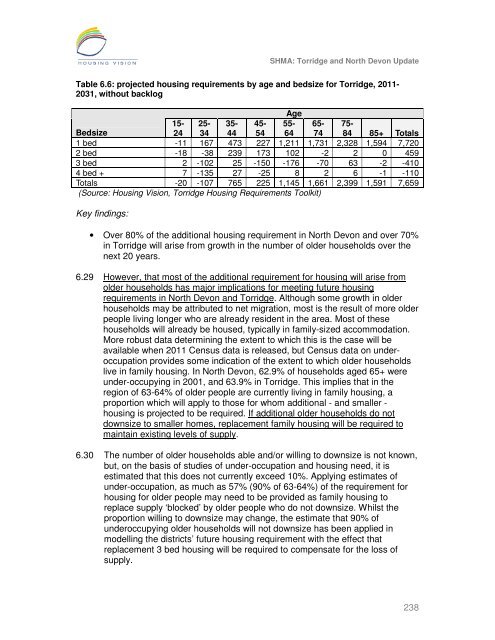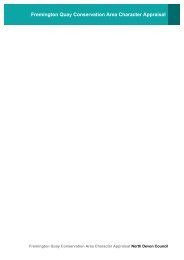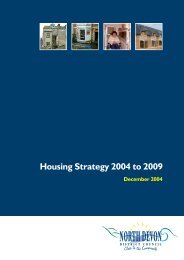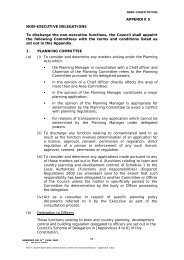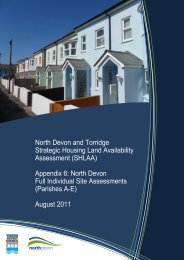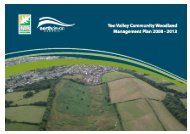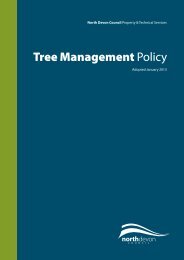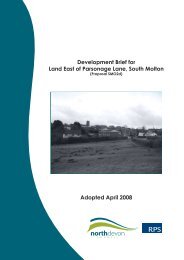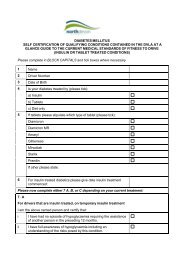Strategic Housing Market Assessment - North Devon District Council
Strategic Housing Market Assessment - North Devon District Council
Strategic Housing Market Assessment - North Devon District Council
Create successful ePaper yourself
Turn your PDF publications into a flip-book with our unique Google optimized e-Paper software.
SHMA: Torridge and <strong>North</strong> <strong>Devon</strong> Update<br />
Table 6.6: projected housing requirements by age and bedsize for Torridge, 2011-<br />
2031, without backlog<br />
Age<br />
Bedsize<br />
15-<br />
24<br />
25-<br />
34<br />
35-<br />
44<br />
45-<br />
54<br />
55-<br />
64<br />
65-<br />
74<br />
75-<br />
84 85+ Totals<br />
1 bed -11 167 473 227 1,211 1,731 2,328 1,594 7,720<br />
2 bed -18 -38 239 173 102 -2 2 0 459<br />
3 bed 2 -102 25 -150 -176 -70 63 -2 -410<br />
4 bed + 7 -135 27 -25 8 2 6 -1 -110<br />
Totals -20 -107 765 225 1,145 1,661 2,399 1,591 7,659<br />
(Source: <strong>Housing</strong> Vision, Torridge <strong>Housing</strong> Requirements Toolkit)<br />
Key findings:<br />
• Over 80% of the additional housing requirement in <strong>North</strong> <strong>Devon</strong> and over 70%<br />
in Torridge will arise from growth in the number of older households over the<br />
next 20 years.<br />
6.29 However, that most of the additional requirement for housing will arise from<br />
older households has major implications for meeting future housing<br />
requirements in <strong>North</strong> <strong>Devon</strong> and Torridge. Although some growth in older<br />
households may be attributed to net migration, most is the result of more older<br />
people living longer who are already resident in the area. Most of these<br />
households will already be housed, typically in family-sized accommodation.<br />
More robust data determining the extent to which this is the case will be<br />
available when 2011 Census data is released, but Census data on underoccupation<br />
provides some indication of the extent to which older households<br />
live in family housing. In <strong>North</strong> <strong>Devon</strong>, 62.9% of households aged 65+ were<br />
under-occupying in 2001, and 63.9% in Torridge. This implies that in the<br />
region of 63-64% of older people are currently living in family housing, a<br />
proportion which will apply to those for whom additional - and smaller -<br />
housing is projected to be required. If additional older households do not<br />
downsize to smaller homes, replacement family housing will be required to<br />
maintain existing levels of supply.<br />
6.30 The number of older households able and/or willing to downsize is not known,<br />
but, on the basis of studies of under-occupation and housing need, it is<br />
estimated that this does not currently exceed 10%. Applying estimates of<br />
under-occupation, as much as 57% (90% of 63-64%) of the requirement for<br />
housing for older people may need to be provided as family housing to<br />
replace supply ‘blocked’ by older people who do not downsize. Whilst the<br />
proportion willing to downsize may change, the estimate that 90% of<br />
underoccupying older households will not downsize has been applied in<br />
modelling the districts’ future housing requirement with the effect that<br />
replacement 3 bed housing will be required to compensate for the loss of<br />
supply.<br />
238


